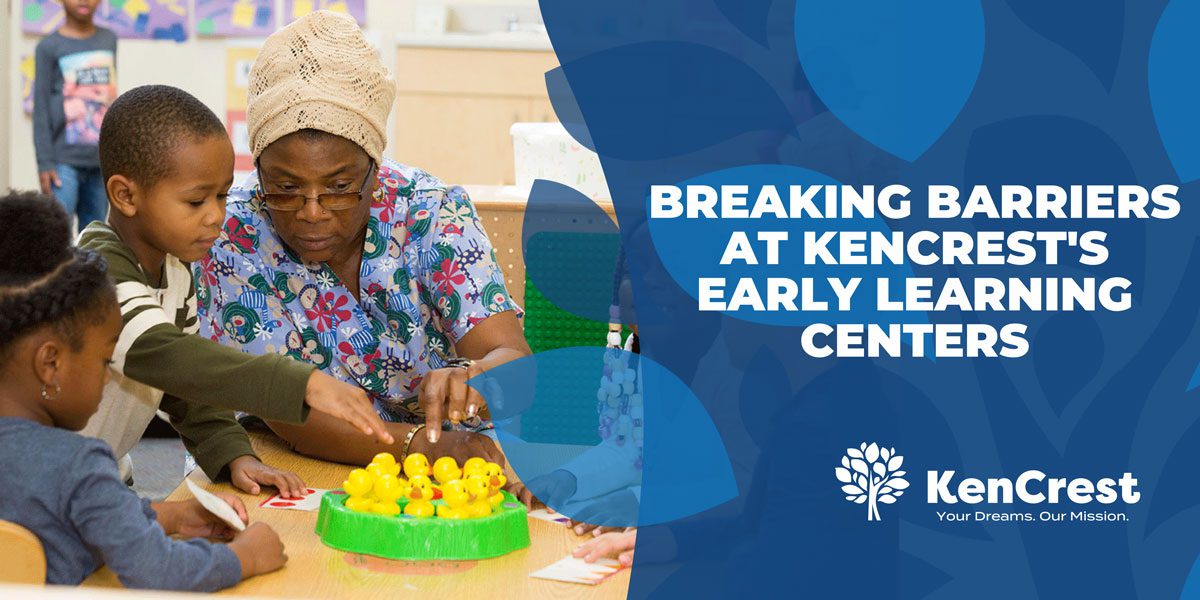Breaking Barriers at KenCrest’s Early Learning Centers

In 2019, KenCrest’s Early Learning Centers began using trauma-informed training to ensure the best success for our little learners.
By Sydney Kerelo
A 2010 study by Briggs and Gowan showed that approximately one in four children experienced or witnessed a traumatic event that could change their lives before age four. Additional studies show that trauma experienced in childhood is linked to adverse health, social, and economic outcomes.

This is why Crittenton Children’s Center experts developed Trauma Smart—a community-based prevention program modeled on evidence-based interventions that help children and adults address the negative impact of violence and trauma.
For 12 years, Trauma Smarts provided training to schools and agencies to strengthen their learning environment and help teachers develop the skills needed to manage the impact of trauma for future success.
In 2019, Trauma Smart came to KenCrest, where they began utilizing its ten two-hour modules to help teachers, staff, and anyone within the seven Early Learning Centers learn proper methods to help children thrive.
Trauma Smart breaks down a child’s emotions and behaviors by teaching people to look through a trauma lens, understand universal precautions, learn the Trauma Smart Approach, and understand the Attachment, Regulation, and Competency (ARC) Framework.
The ARC framework was built upon four key areas: normative childhood development, traumatic stress, attachment, and risk and resilience. It helps to identify essential childhood skills which are shown to be negatively affected by attachment disruptions or traumatic stress.
Many of KenCrest’s Early Learning im/migrant students have been exposed to traumatic situations, such as coming over from the African Congo or being stuck on a boat for weeks as they traveled here from Mexico. Many families in Philadelphia have experienced gun violence or have lost a loved one suddenly, and they will come into the Early Learning Centers with many feelings and emotions, resulting in them acting out during class.
The Trauma Smart training helps teachers understand why those children express big behaviors and assists students and teachers as they work through them.
“The first thing we do [to enact Trauma Smart] is to build consistency and routine within the classroom to promote safety. We have our teachers focus on building attachment, safety, and connection before anything else because we found that the children don’t know how they feel. So, we must give them those words,” says Christina Stiles, an Educational Program Coordinator with KenCrest. “Often, we notice that children with these big emotions are the ones with big behaviors, and because they can’t correlate the emotion, they can’t regulate it.”

Once the teachers have labeled their emotions, they can give them a calming or connecting activity—like reading a book or working on a puzzle with a friend.
Using the Trauma Smart training, teachers can now identify the emotion a child is feeling rather than the behavior they are seeing. It allows them to develop a deeper understanding of each child by thinking about what happened to them rather than what’s wrong with them.
But it doesn’t just help children; parents, staff, and teachers also benefit from its training because of its universal approach.
“Say a kid comes in fighting; the human thing to do is to try to squash it,” adds Brennan. “But with Trauma Smart, it helps adults realize that they must manage their behavior and their responses, and giving people the language and ideas around that helps children become less reactive.”

When KenCrest’s Trauma Smart was initially launched, all teachers, program managers, office staff, and maintenance workers participated in the training modules to learn how to understand a child’s emotions rather than just seeing their behaviors. In turn, the training helped staff members understand their feelings and better ways to regulate them and how to help children do it too.
After the initial ten trainings, a Trauma Informed Care Team was created as a small group of staff at each Center to understand what was happening in each Center and help make a change. Since its launch, the group has met monthly to discuss behaviors, strategies, and ways to impact KenCrest’s Early Learning students and families the most.
“The site level even hosts a Smart Connections program for families,” says Stiles. “So, it comes from the family service worker who does the intake with the family, so it’s coming from someone familiar. So, we give families routine charts to make at home with their child for morning or bedtime, offer recommendations on books that have been shared with families, encourage the use of different activities like drawing your feelings, and more.”
Want to learn more about KenCrest’s Early Learning Centers? Click the link below!
